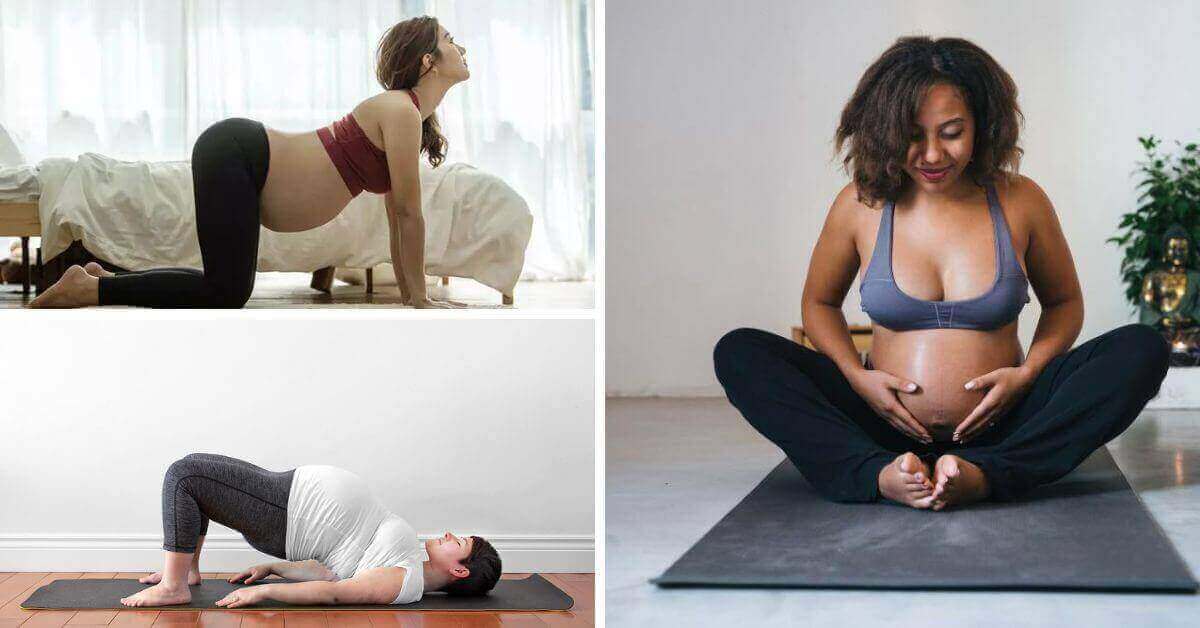The third trimester of pregnancy is a time of anticipation, excitement, and physical transformation. As your body prepares for childbirth, you may experience increased discomfort, swelling, back pain, and fatigue. This is where yoga poses for third trimester pregnancy can play a crucial role in keeping you comfortable, flexible, and mentally prepared for labor.
Prenatal yoga is more than just stretching it enhances circulation, strengthens pelvic floor muscles, and improves posture to ease common pregnancy discomforts. Unlike high-impact exercises, yoga offers gentle yet effective movements that support your growing belly while reducing stress and anxiety. Additionally, practicing mindful breathing techniques during yoga can prepare you for labor by promoting relaxation and pain management.
However, not all yoga poses are safe in the third trimester. Deep backbends, intense core work, or positions that put pressure on the abdomen should be avoided. Instead, focusing on gentle, restorative poses can help relieve tension, support the lower back, and open the hips, making labor easier. Whether you are new to yoga or a seasoned practitioner, incorporating these pregnancy-safe poses into your routine can significantly enhance your physical and emotional well-being during this final stage of pregnancy.
Benefits of Yoga in the Third Trimester
Practicing yoga poses for third trimester pregnancy provides a wide range of physical, mental, and emotional benefits. As your body prepares for labor, yoga can help you stay strong, flexible, and relaxed, easing common pregnancy discomforts and promoting overall well-being. Below are some key benefits of incorporating yoga into your third-trimester routine.
1. Relieves Back and Hip Pain
By the third trimester, many pregnant women experience lower back pain, hip discomfort, and sciatica due to the growing baby shifting the body’s center of gravity. This added pressure can strain the spine and pelvic joints. Yoga can help alleviate this pain by:
✔ Strengthening the back muscles – Gentle poses like Cat-Cow and Child’s Pose help to release tension in the spine and support the lower back.
✔ Opening the hips – Deep hip-opening poses such as Butterfly Pose and Malasana (Yogi Squat) improve flexibility and reduce stiffness in the pelvic area.
✔ Correcting posture – As your belly grows, you may start arching your back, leading to more discomfort. Yoga improves spinal alignment and posture to minimize pain.
By incorporating safe yoga postures into your routine, you can ease tension in your hips and lower back, making everyday movements and sleep more comfortable.
2. Improves Circulation and Reduces Swelling
Swelling (also known as edema) is common in the third trimester as fluid retention increases. Poor circulation can cause swelling in the feet, ankles, and hands, leading to discomfort. Yoga helps to enhance blood flow and reduce swelling by:
✔ Encouraging gentle movement – Poses that involve stretching and mild inversions (like Legs Up the Wall Pose) help improve circulation.
✔ Reducing fluid retention – Yoga encourages lymphatic drainage, which helps reduce excess fluid buildup in the body.
✔ Enhancing oxygen supply to the baby – Improved circulation ensures that oxygen and essential nutrients reach the baby efficiently, promoting healthy fetal development.
✔ Minimizing leg cramps and numbness – Stretching the calves, ankles, and feet in yoga can prevent painful leg cramps, a common third-trimester complaint.
Consistently practicing prenatal-friendly yoga can help expecting mothers feel lighter and more comfortable by reducing swelling and improving circulation.
3. Enhances Pelvic Floor Strength
A strong pelvic floor is essential for supporting the uterus, bladder, and bowel, especially during pregnancy and childbirth. As the baby grows, the pelvic floor muscles bear more weight, which can lead to weakness and issues like urinary incontinence. Yoga strengthens these muscles by:
✔ Engaging the pelvic floor in specific poses – Yoga postures such as Bridge Pose and Squats naturally activate and strengthen the pelvic floor.
✔ Improving control during labor – A strong pelvic floor helps you push more effectively during childbirth, making delivery smoother.
✔ Reducing postpartum complications – Strengthening these muscles can help prevent post-birth problems like urinary leakage and pelvic organ prolapse.
Prenatal yoga integrates pelvic floor exercises with breathwork, ensuring that these muscles remain flexible and strong throughout pregnancy and beyond.
4. Supports Better Breathing and Relaxation
Deep breathing techniques are an essential part of prenatal yoga, helping to calm the mind, reduce anxiety, and prepare for labor. As the baby grows, lung capacity may feel restricted, making it harder to take deep breaths. Yoga supports better breathing by:
✔ Teaching diaphragmatic breathing – This technique expands the lungs fully, providing more oxygen to both mother and baby.
✔ Reducing shortness of breath – Poses like Side Stretch and Extended Puppy Pose create more space in the ribcage, allowing for deeper breaths.
✔ Promoting relaxation and better sleep – Mindful breathing lowers stress hormone levels, helping pregnant women sleep more soundly.
✔ Preparing for labor and pain management – Controlled breathing techniques (such as Ujjayi breathing) are useful for managing contractions during childbirth.
By focusing on breath control, yoga helps expectant mothers remain calm and centered, making pregnancy and labor a more positive experience.
5. Prepares the Body for Labor and Delivery
The third trimester is all about preparing for childbirth, and yoga plays a crucial role in enhancing endurance, flexibility, and relaxation techniques needed for labor. Regular yoga practice can help by:
✔ Increasing strength and stamina – Certain poses, such as Goddess Pose and Chair Pose, help build lower body strength, which is essential for labor.
✔ Encouraging hip mobility – Hip-opening poses like Pigeon Pose and Bound Angle Pose prepare the pelvis for childbirth, making delivery smoother.
✔ Practicing mindfulness and relaxation – Yoga teaches the importance of surrendering to the moment, which can help mothers remain calm and focused during contractions.
✔ Teaching birthing positions – Some yoga postures, such as hands-and-knees positions, mimic labor positions, allowing the baby to move into the optimal birthing position.
By incorporating prenatal yoga into your daily routine, you can physically and mentally prepare for labor, increasing your chances of a more positive and manageable childbirth experience.
Safety Tips for Prenatal Yoga in the Third Trimester
Practicing yoga poses for third trimester pregnancy can be highly beneficial, but safety should always come first. As your body undergoes significant changes in preparation for childbirth, it’s essential to modify your yoga practice to ensure both you and your baby remain safe and comfortable. Below are some important safety guidelines to follow during prenatal yoga in the third trimester.
1. Avoid Deep Twists and Intense Backbends
Your growing belly shifts your center of gravity and stretches your abdominal muscles, making deep twists and backbends risky. These movements can cause strain and even reduce blood flow to the uterus. Instead:
✔ Opt for gentle spinal twists that focus on the upper back while keeping the belly stable.
✔ Use open twists (twisting away from the belly) rather than closed twists.
✔ Avoid backbends that overly stretch the abdominal muscles, such as Wheel Pose or Cobra Pose.
2. Choose Stable and Supported Poses
As your balance changes, it’s easier to lose stability. Falling poses a serious risk during pregnancy, so prioritize stability:
✔ Use a wall, chair, or yoga block for support in balancing poses like Tree Pose or Warrior III.
✔ Avoid standing poses that require deep balance, such as Half Moon Pose.
✔ Practice poses on a yoga mat with good grip to prevent slipping.
3. Avoid Lying Flat on Your Back
From the second trimester onward, lying on your back for extended periods can compress the inferior vena cava, a major vein that carries blood from the lower body to the heart. This can lead to dizziness, nausea, or reduced circulation. Instead:
✔ Opt for side-lying poses using pillows or bolsters for support.
✔ Modify Savasana (Final Relaxation Pose) by lying on your left side rather than on your back.
4. Do Not Overstretch or Push Yourself Too Hard
During pregnancy, your body produces relaxin, a hormone that increases flexibility by loosening ligaments. While this is helpful for childbirth, it also makes you more prone to overstretching and injury. To prevent this:
✔ Listen to your body never force yourself into a deep stretch.
✔ Avoid extreme flexibility poses like Splits or Pigeon Pose with deep bends.
✔ Maintain a gentle, comfortable range of motion to avoid muscle strain.
5. Prioritize Deep Breathing and Avoid Breath Retention
Controlled breathing is an essential part of prenatal yoga, but certain breathing techniques can be unsafe in pregnancy. Avoid practices like breath retention (kumbhaka) or forceful breathing (kapalabhati), as they may reduce oxygen flow to the baby. Instead:
✔ Focus on slow, deep diaphragmatic breathing to increase oxygen intake.
✔ Practice Ujjayi breath (ocean breath) to calm the nervous system and improve focus.
✔ Avoid fast-paced breathing techniques that could cause dizziness.
6. Modify Forward Bends and Hip Openers
Deep forward folds and intense hip stretches can place unnecessary pressure on your belly and lower back. Instead of traditional poses:
✔ Widen your stance in forward folds to make space for your belly.
✔ Use a yoga block to support yourself in poses like Forward Bend and Malasana (Yogi Squat).
✔ Avoid deep lunges or extreme hip stretches that may overstretch ligaments.
7. Stay Hydrated and Avoid Overheating
Pregnant women are more sensitive to overheating, which can lead to dizziness, dehydration, and increased heart rate. To stay safe:
✔ Drink plenty of water before, during, and after yoga practice.
✔ Avoid hot yoga or heated rooms stick to a cool, well-ventilated space.
✔ Take breaks as needed, and stop if you feel lightheaded or overheated.
8. Listen to Your Body and Modify as Needed
The most important rule in prenatal yoga is listening to your body. Every pregnancy is different, and what feels good for one person may not be safe for another. Always:
✔ Stop immediately if you feel pain, dizziness, or discomfort.
✔ Modify poses to suit your comfort level and energy levels.
✔ Consult your doctor or a certified prenatal yoga instructor if you are unsure about any pose.
Best Yoga Poses for Third Trimester Pregnancy
As your body prepares for labor, practicing yoga can help alleviate discomfort, enhance flexibility, and promote relaxation. Below are the best yoga poses for third trimester pregnancy, designed to support your changing body while ensuring safety and comfort.

1. Butterfly Pose (Baddha Konasana)
This gentle hip opener improves blood circulation and flexibility in the pelvic region, helping prepare your body for childbirth. It also relieves tension in the lower back, making it an excellent pose for the third trimester.
✔ Opens the hips and inner thighs
✔ Improves flexibility in the pelvic region
✔ Stimulates blood flow to the lower body
How to Do It:
- Sit on the floor with your legs bent, bringing the soles of your feet together.
- Hold your feet and let your knees gently drop toward the floor.
- Keep your spine straight and take slow, deep breaths.
- Hold for 30 seconds to 1 minute.
2. Cat-Cow Pose (Marjaryasana-Bitilasana)
This pose encourages spinal flexibility, relieves lower back pain, and promotes breath awareness. It also helps to reduce pregnancy-related tension in the shoulders and neck while improving posture.
✔ Relieves lower back pain
✔ Encourages spinal flexibility
✔ Promotes relaxation and breath awareness
How to Do It:
- Get on all fours with your wrists under your shoulders and knees under your hips.
- Inhale, arch your back, lift your tailbone, and look up (Cow Pose).
- Exhale, round your spine, tuck your chin, and pull your belly inward (Cat Pose).
- Repeat 5–10 times, moving with your breath.
3. Child’s Pose (Balasana) with Knees Wide
A great resting pose, Child’s Pose releases tension in the lower back, hips, and shoulders. It also encourages deep breathing, promoting relaxation and emotional balance in the final trimester.
✔ Gently stretches the lower back and hips
✔ Relieves tension in the belly and spine
✔ Helps calm the nervous system
How to Do It:
- Kneel on the floor and widen your knees to accommodate your belly.
- Sit back on your heels and extend your arms forward.
- Rest your forehead on the mat and breathe deeply.
- Hold for 1–2 minutes.
4. Goddess Pose (Utkata Konasana)
This pose strengthens the legs, enhances blood circulation, and helps open the hips for labor. It also promotes stability and endurance, which are essential during the third trimester.
✔ Strengthens the legs and pelvic floor
✔ Increases blood circulation
✔ Helps prepare for labor by opening the hips
How to Do It:
- Stand with your feet wide apart and toes pointing slightly outward.
- Bend your knees and lower into a squat, keeping your back straight.
- Place your hands on your thighs or bring them into a prayer position.
- Hold for 30 seconds to 1 minute while breathing deeply.
5. Seated Side Stretch
This pose increases flexibility in the ribs and spine while relieving tightness in the shoulders. It also encourages deeper breathing, which can be beneficial during labor and delivery.
✔ Improves flexibility in the ribs and torso
✔ Relieves tension in the back and shoulders
✔ Encourages deep breathing
How to Do It:
- Sit cross-legged or in a comfortable seated position.
- Extend your right arm overhead and lean gently to the left.
- Keep your opposite hand on the ground for support.
- Hold for 20–30 seconds, then switch sides.
6. Standing Forward Bend (Uttanasana) with Support
This forward bend helps release tension in the lower back and hamstrings while encouraging blood flow to the brain. It can also help relieve pregnancy-related headaches and fatigue.
✔ Relieves back pain and tension
✔ Encourages blood flow to the brain
✔ Promotes relaxation
How to Do It:
- Stand with your feet hip-width apart.
- Bend forward at the hips, allowing your upper body to hang.
- Use a chair or blocks for support if needed.
- Hold for 20–30 seconds while breathing deeply.
7. Malasana (Yogi Squat) with Support
This deep squat strengthens the pelvic floor and prepares the body for labor. It also aids digestion and relieves bloating, which is common in the third trimester.
✔ Opens the hips and strengthens the pelvic floor
✔ Helps prepare the body for childbirth
✔ Improves digestion and relieves bloating
How to Do It:
- Stand with feet slightly wider than hip-width apart.
- Lower into a squat, keeping your heels on the ground if possible.
- Bring your hands into a prayer position at your chest.
- Use a block under your hips for support if needed.
- Hold for 20–30 seconds.
8. Reclined Bound Angle Pose (Supta Baddha Konasana)
This restorative pose encourages relaxation, reduces stress, and increases blood flow. It also gently stretches the thighs and hips without straining the abdomen.
✔ Promotes deep relaxation
✔ Reduces tension in the lower body
✔ Encourages better circulation
How to Do It:
- Lie back on a bolster or pillows for support.
- Bring the soles of your feet together and let your knees fall open.
- Place your hands on your belly or by your sides.
- Relax and breathe deeply for 1–2 minutes.
9. Pelvic Tilts (Bridge Pose Modification)
This gentle movement strengthens the lower back and pelvic muscles, relieving pressure on the spine. It also improves posture and can help with lower back pain.
✔ Strengthens the lower back and pelvic muscles
✔ Relieves pressure on the spine
✔ Improves posture
How to Do It:
- Lie on your back with knees bent and feet hip-width apart.
- Lift your hips slightly, keeping your lower back on the mat.
- Hold for a few seconds, then lower back down.
- Repeat 10–12 times.
10. Side-Lying Savasana
A variation of the traditional Savasana, this pose is a safe and comfortable way to relax in the third trimester. It reduces lower back strain and enhances deep breathing.
✔ Enhances relaxation and stress relief
✔ Reduces lower back discomfort
✔ Prepares the body for sleep
How to Do It:
- Lie on your left side with a pillow between your knees for support.
- Place a cushion under your head for comfort.
- Close your eyes and focus on deep breathing.
- Stay in this position for 2–5 minutes.
Practicing yoga poses for third trimester pregnancy helps alleviate discomfort, improve flexibility, and prepare the body for labor. Always prioritize safety by modifying poses as needed and consulting a healthcare provider if unsure. By incorporating these poses into your daily routine, you can feel stronger, more balanced, and mentally prepared for childbirth.
Breathing Exercises to Support Labor
Breathing exercises play a vital role in labor by helping manage pain, reducing stress, and ensuring sufficient oxygen supply for both mother and baby. Controlled breathing can also promote relaxation, making contractions more manageable. Below are the best breathing techniques to support labor and delivery.

1. Deep Belly Breathing (Diaphragmatic Breathing)
Deep belly breathing helps increase oxygen flow, calms the nervous system, and keeps you relaxed during contractions. It is a foundational breathing technique that can be practiced throughout pregnancy and labor.
✔ Promotes relaxation and reduces tension
✔ Increases oxygen supply for mother and baby
✔ Helps conserve energy for labor
How to Do It:
- Sit or lie down in a comfortable position.
- Place one hand on your belly and the other on your chest.
- Inhale deeply through your nose, allowing your belly to expand.
- Exhale slowly through your mouth, letting your belly fall.
- Repeat for several minutes, focusing on slow, steady breaths.
2. Counted Breathing (4-4-6 Technique)
This method focuses on maintaining a steady rhythm of breath to help control contractions and promote focus during labor.
✔ Helps maintain a calm and steady breathing pattern
✔ Provides a focal point during contractions
✔ Reduces anxiety and muscle tension
How to Do It:
- Inhale deeply through your nose for 4 counts.
- Hold the breath for 4 counts.
- Exhale slowly through your mouth for 6 counts.
- Repeat as needed, especially during early labor.
3. Slow Paced Breathing
Slow-paced breathing helps conserve energy and maintain relaxation, especially in the early stages of labor. It keeps the body loose and reduces muscle tension.
✔ Slows the heart rate and promotes relaxation
✔ Helps manage pain by keeping muscles relaxed
✔ Prevents hyperventilation during contractions
How to Do It:
- Take a slow, deep breath in through your nose.
- Exhale even more slowly through your mouth.
- Focus on elongating each breath while keeping the body relaxed.
- Continue this pattern for as long as needed.
4. Patterned Breathing (Hee-Hee-Hoo Method)
This well-known Lamaze breathing technique helps women stay focused and manage contractions effectively by controlling their breathing rhythm.
✔ Helps with pain management during contractions
✔ Provides a sense of control over breathing
✔ Prevents panic and excessive tension
How to Do It:
- Inhale deeply through your nose.
- Exhale in a pattern: “hee-hee-hoo” (short-short-long).
- Maintain a steady rhythm and adjust the tempo as needed.
- Use this technique during active labor to stay focused.
5. Blowing Out the Candle
This technique encourages short, controlled breaths, which can be useful when pushing during labor. It helps prevent premature pushing and keeps breathing steady.
✔ Helps control the urge to push too soon
✔ Encourages steady, focused breathing
✔ Reduces tension in the pelvic floor
How to Do It:
- Inhale deeply through your nose.
- Exhale in short, gentle puffs as if blowing out a candle.
- Focus on keeping your breath steady and controlled.
- Use this technique when contractions intensify.
6. Ujjayi Breathing (Ocean Breath)
This deep, rhythmic breath is commonly used in yoga and can help with endurance during labor. It promotes relaxation and provides a calming effect.
✔ Enhances endurance and focus
✔ Helps manage pain naturally
✔ Creates a soothing and meditative state
How to Do It:
- Inhale deeply through your nose while slightly constricting your throat.
- Exhale through your nose with a soft “ocean” sound.
- Maintain a steady, slow rhythm.
- Use this technique during contractions to stay centered.
7. Transitional Breathing
This breathing technique is helpful during the most intense phase of labor, known as transition. It helps manage strong contractions and keeps the body from tensing up.
✔ Helps manage pain and intensity during transition
✔ Prevents panic and hyperventilation
✔ Keeps breathing rhythmic and steady
How to Do It:
- Take short, quick breaths in and out through your mouth.
- Maintain a steady, controlled rhythm.
- Keep shoulders and facial muscles relaxed.
- Continue until the contraction subsides.
Final Thoughts
Practicing yoga poses for third trimester pregnancy can significantly benefit both mother and baby. It enhances flexibility, strengthens the body for labor, promotes relaxation, and reduces common discomforts like back pain and swelling. By incorporating gentle poses, breathing exercises, and mindful movement, expectant mothers can feel more prepared for childbirth while nurturing their emotional and physical well-being.
However, safety should always be the priority. Listening to your body, modifying poses as needed, and seeking guidance from a qualified prenatal yoga instructor can help prevent strain or injury. Combining yoga with other healthy habits such as proper nutrition, hydration, and rest can create a holistic approach to a smoother pregnancy and delivery.
As your due date approaches, focus on deep breathing and relaxation techniques to help you stay calm and centered. Yoga is not just about movement; it is a powerful tool for managing stress, preparing for labor, and embracing the journey of motherhood with confidence.







